The Cambridge History of China. Vol. 06. Alien Regimes and Border States, 907-1368
Подождите немного. Документ загружается.

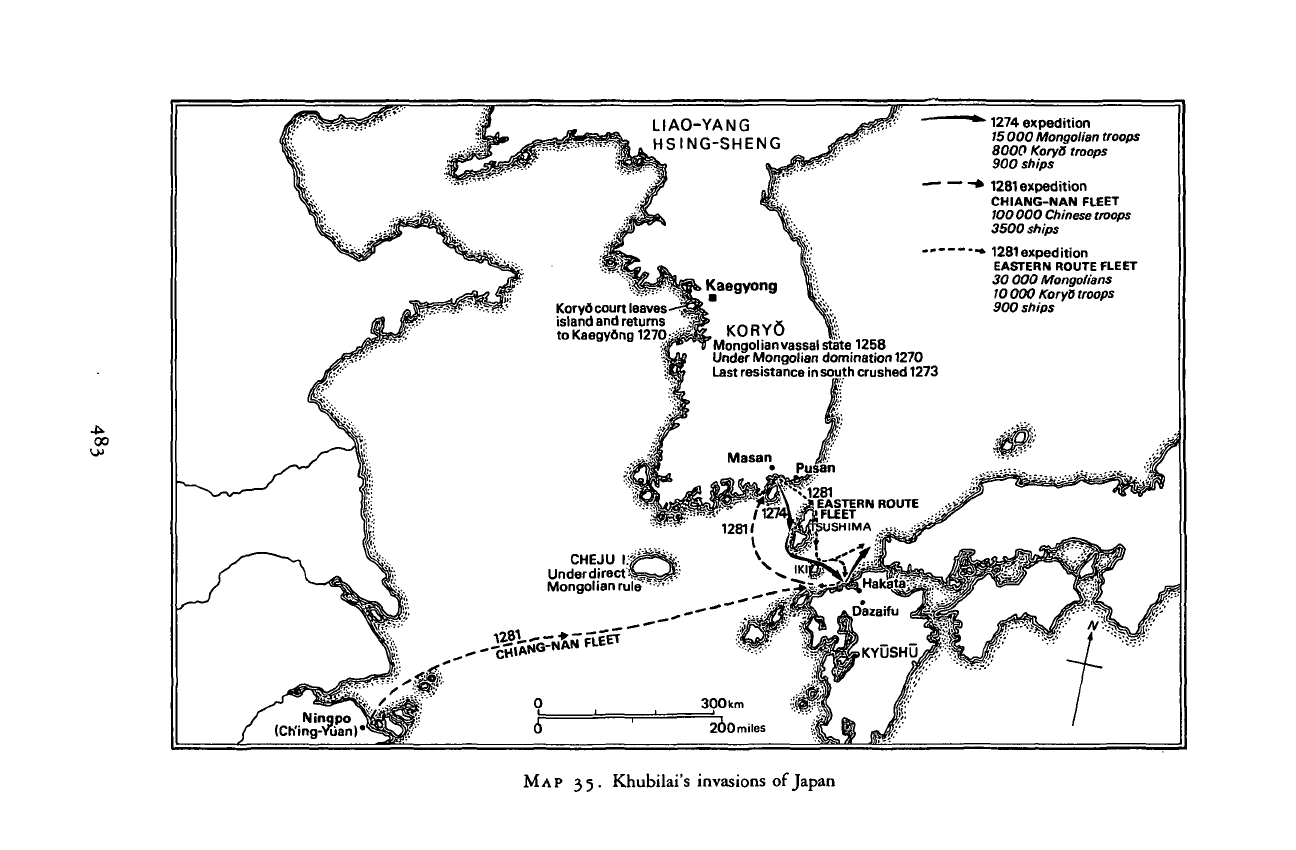
1274 expedition
75
000
Mongolian troops
8000
KoryB troops
900 ships
1281
expedition
CHIANG-NAN FLEET
700
000
Chinese troops
3500
ships
1281
expedition
EASTERN ROUTE FLEET
30
000
Mongolians
10
000
KoryB troops
900 ships
LIAO-YANG
HSING-SHENG
Koryo court leaves
island
and
returns
'
to Kaegyong
\110M
KORYO
Mongolian
vassal
state
1258
Under Mongolian domination 1270
Last resistance
in south
crushed 1273
••.1281
EASTERN ROUTE
/
1ZA»anj
FLEET
CHEJU
I.
Underdirect
Mongolian rule
Ninqpo
(Ch'ing-Yiian)*
MAP
35. Khubilai's invasions of Japan
Cambridge Histories Online © Cambridge University Press, 2008

484 THE REIGN OF KHUBILAI KHAN
the northern forces had occupied Iki, and so they then headed for the main
island of Kyushu. Meanwhile, the southern troops had finally completed
their preparations and headed for a rendezvous in Kyushu. With such a
powerful military machine and with such momentum, victory ought to have
been within their grasp.
1
'
8
Yet the expedition failed miserably. Tensions between the Mongolian com-
manders and the Chinese leaders weakened the expeditionary force. The
Chinese troops, who comprised the vast majority of
the
soldiers, had scarcely
any stake in the combat and so did not exert themselves to put up a strong
fight. Moreover, when they landed in Kyushu, they were afforded no protec-
tion from either their enemies or the elements. They had to camp out in the
open without a castle, stronghold, or town that would provide adequate
defense and from which they could make forays against the enemy. The two
armies fought for almost two months, but no clear victor emerged. Then a
natural catastrophe interceded to dash the hopes of the Mongols. On 15
August 1281, a typhoon struck the coast of Kyushu, and almost one-half
of
the Mongolian force perished during the storms. The Japanese maintained
that the typhoon was sent by the gods to protect their country, that it was a
"divine wind" (Japanese:
kamikaze)
and a guarantee that the gods would
never allow Japan's enemies to conquer and occupy their territory.
For the Mongols, the defeat was a devastating shock. Their failure shat-
tered their mantle of invincibility, as Khubilai's subjects now realized
that the Mongols were vulnerable. One of the principal underpinnings of
their power
—
the psychological edge of terror that they held over their
opponents
—
was badly shaken, if not destroyed. Most damaging of all was
the tremendous expense incurred in the expedition, which precipitated
some of the revenue problems that compelled Khubilai to turn to such
financial administrators as Ahmad and Lu Shih-jung, whom the Chinese
hated and despised. Khubilai's efforts once again reveal the same lack of
control noticeable in his financial policies of the 1280s.
Campaigns
in
Southeast
Asia
Similarly, Khubilai's campaigns in Southeast Asia were, for the most part, ill
conceived and resulted in some devastating reverses. These expeditions were
inspired by the Mongols' traditional expansionist ambitions as well as
Khubilai's personal need for new conquests to give him additional claims to
legitimacy. Neither he nor the court considered the tropical heat and rain,
118 A useful summary of the Japanese campaign is given in Chen Pang-chan, comp., Yuan sbih
chi
sbib
pea mo (Peking, 1979 ed.), pp.
25—31.
Cambridge Histories Online © Cambridge University Press, 2008
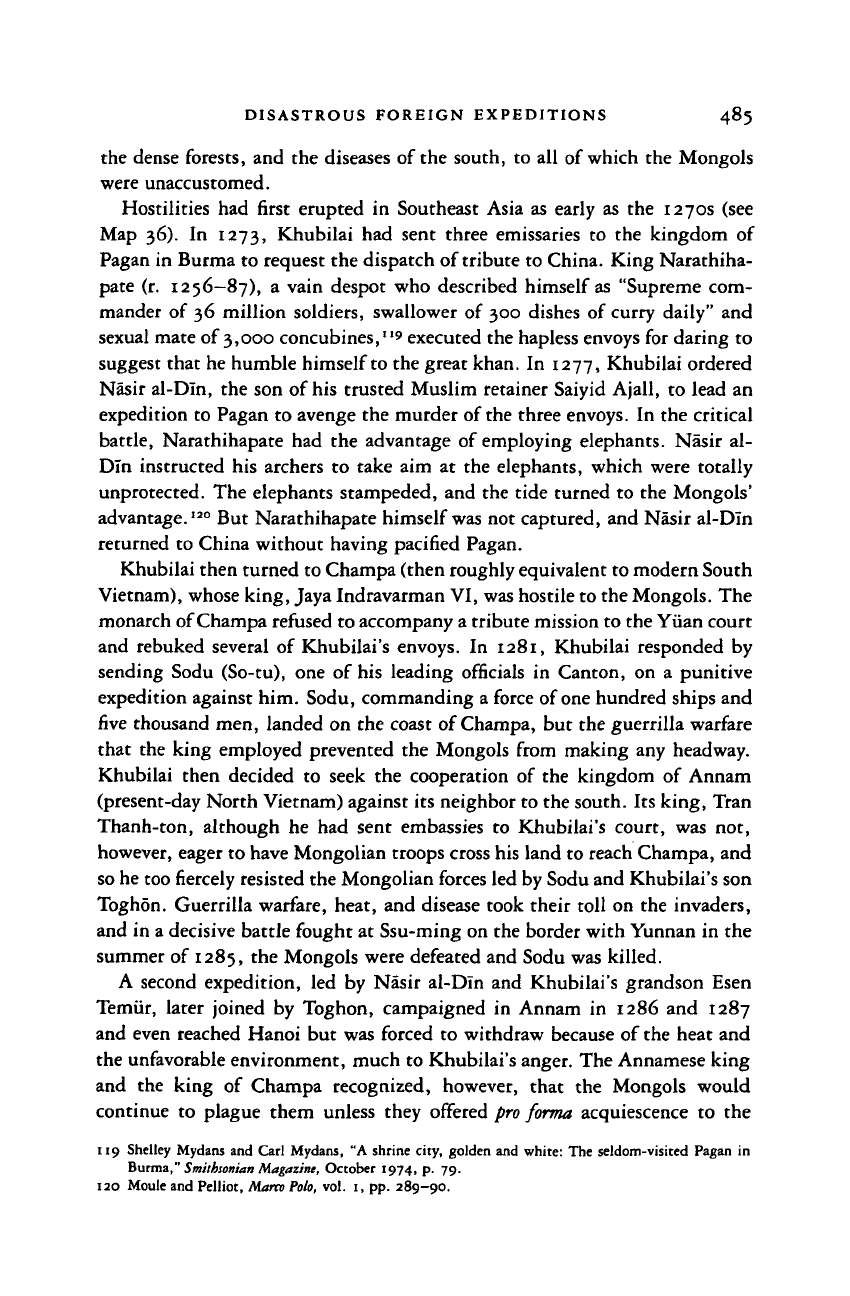
DISASTROUS FOREIGN EXPEDITIONS 485
the dense forests, and the diseases of the south, to all of which the Mongols
were unaccustomed.
Hostilities had first erupted in Southeast Asia as early as the 1270s (see
Map 36). In 1273, Khubilai had sent three emissaries to the kingdom of
Pagan in Burma to request the dispatch of tribute to China. King Narathiha-
pate (r. 1256-87), a vain despot who described himself as "Supreme com-
mander of 36 million soldiers, swallower of 300 dishes of curry daily" and
sexual mate of 3,000 concubines,"
9
executed the hapless envoys for daring to
suggest that he humble himself
to
the great khan. In 1277, Khubilai ordered
Nasir al-Din, the son of his trusted Muslim retainer Saiyid Ajall, to lead an
expedition to Pagan to avenge the murder of the three envoys. In the critical
battle, Narathihapate had the advantage of employing elephants. Nasir al-
Dln instructed his archers to take aim at the elephants, which were totally
unprotected. The elephants stampeded, and the tide turned to the Mongols'
advantage.
120
But Narathihapate himself
was
not captured, and Nasir al-Dln
returned to China without having pacified Pagan.
Khubilai then turned to Champa (then roughly equivalent to modern South
Vietnam), whose king, Jaya Indravarman VI, was hostile to the Mongols. The
monarch of Champa refused to accompany a tribute mission to the Yuan court
and rebuked several of Khubilai's envoys. In 1281, Khubilai responded by
sending Sodu (So-tu), one of his leading officials in Canton, on a punitive
expedition against him. Sodu, commanding a force of
one
hundred ships and
five thousand men, landed on the coast of
Champa,
but the guerrilla warfare
that the king employed prevented the Mongols from making any headway.
Khubilai then decided to seek the cooperation of the kingdom of Annam
(present-day North Vietnam) against its neighbor to the south. Its king, Tran
Thanh-ton, although he had sent embassies to Khubilai's court, was not,
however, eager to have Mongolian troops cross his land to reach Champa, and
so
he too
fiercely
resisted the Mongolian
forces
led by Sodu and Khubilai's son
Toghon. Guerrilla warfare, heat, and disease took their toll on the invaders,
and in a decisive battle fought at Ssu-ming on the border with Yunnan in the
summer of 1285, the Mongols were defeated and Sodu was killed.
A second expedition, led by Nasir al-Dln and Khubilai's grandson Esen
Temiir, later joined by Toghon, campaigned in Annam in 1286 and 1287
and even reached Hanoi but was forced to withdraw because of the heat and
the unfavorable environment, much to Khubilai's anger. The Annamese king
and the king of Champa recognized, however, that the Mongols would
continue to plague them unless they offered
pro forma
acquiescence to the
119 Shelley Mydans and Carl Mydans, "A shrine city, golden and white: The seldom-visited Pagan in
Burma,"
Smithsonian
Magazine, October 1974, p. 79.
120 Moule and Pelliot, Marco
Polo,
vol. 1, pp. 289-90.
Cambridge Histories Online © Cambridge University Press, 2008
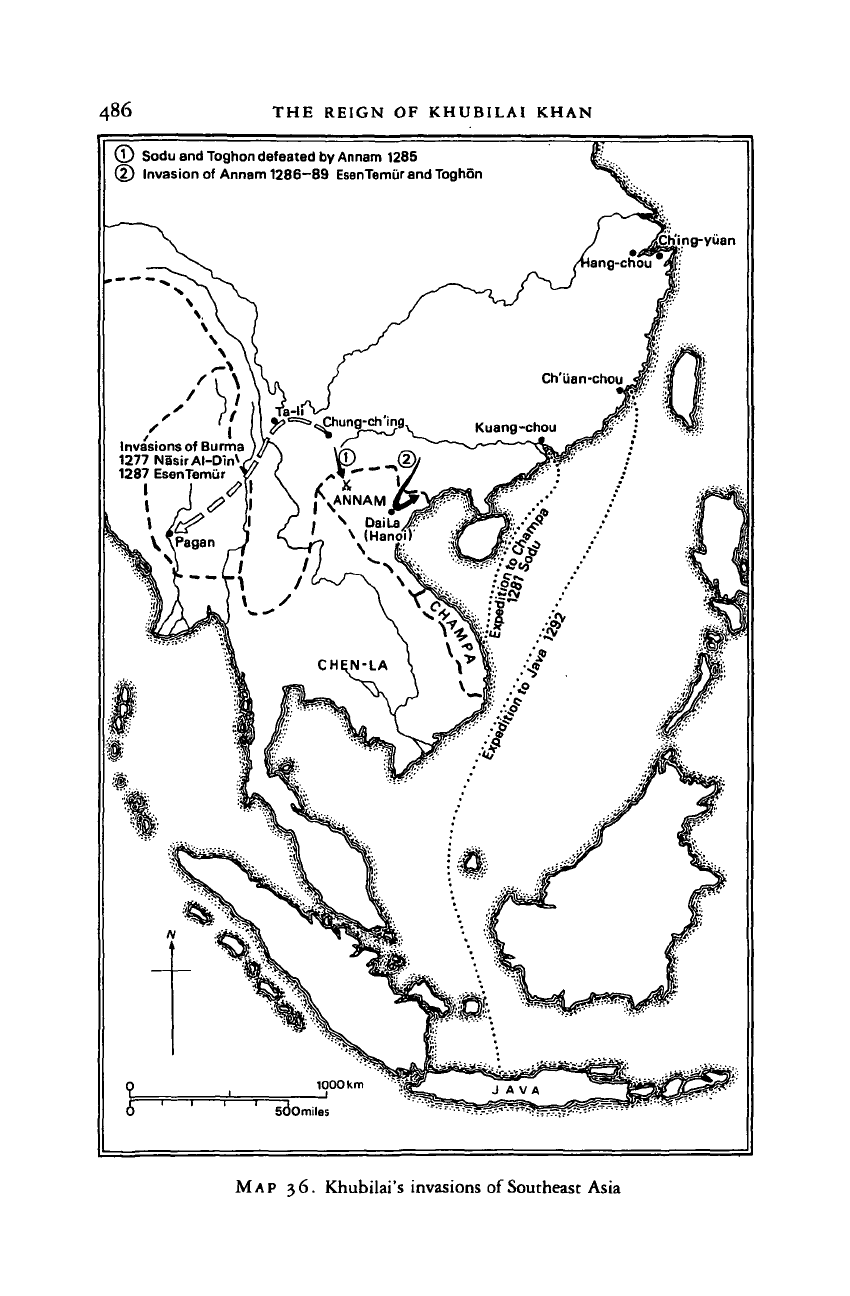
486
THE REIGN OF KHUBILAI KHAN
Sodu and Toghon defeated by Annam 1285
Invasion of Annam 1286-89 EsenTemur and Toghon
ing-yuan
MAP
36. Khubilai's invasions of Southeast Asia
Cambridge Histories Online © Cambridge University Press, 2008
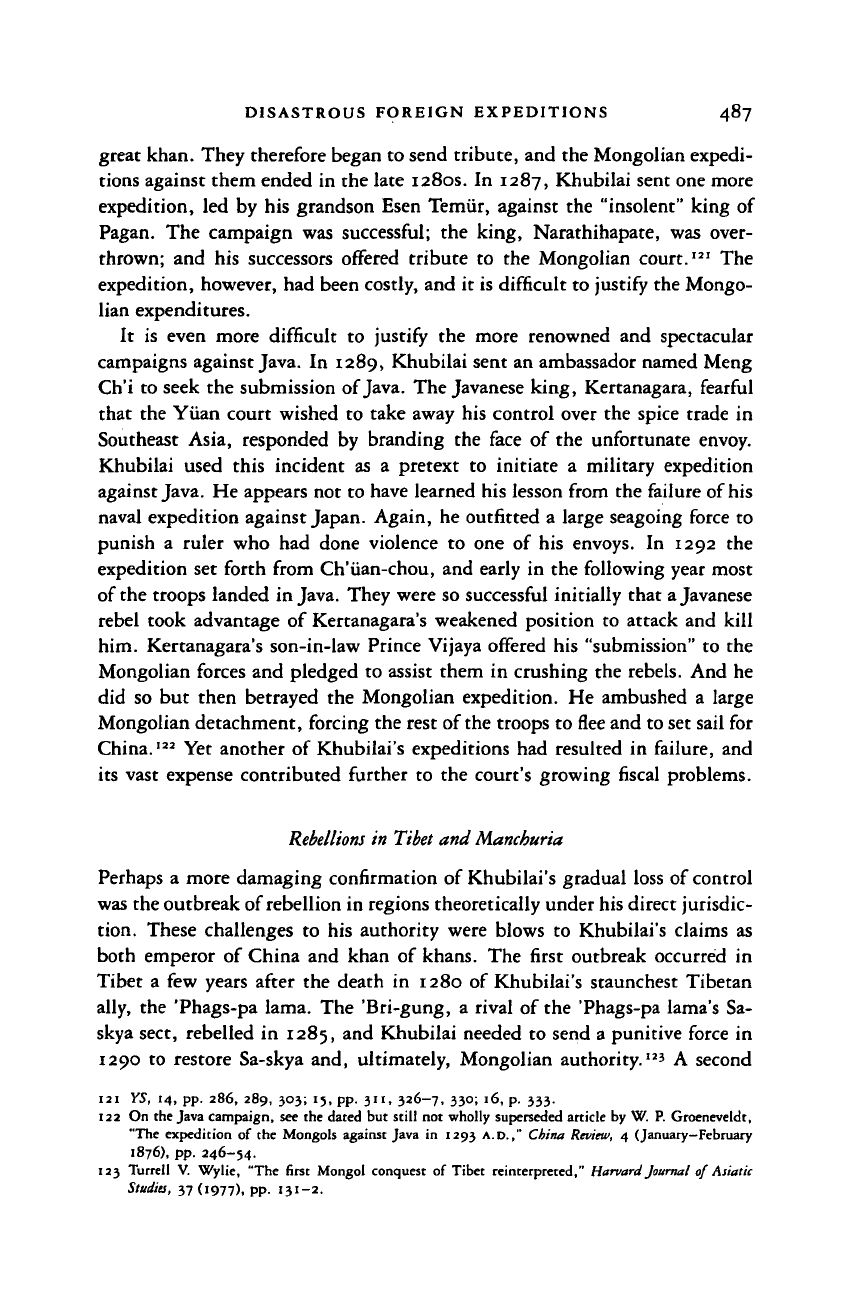
DISASTROUS FOREIGN EXPEDITIONS 487
great khan. They therefore began to send tribute, and the Mongolian expedi-
tions against them ended in the late 1280s. In 1287, Khubilai sent one more
expedition, led by his grandson Esen Temiir, against the "insolent" king of
Pagan. The campaign was successful; the king, Narathihapate, was over-
thrown; and his successors offered tribute to the Mongolian court.
121
The
expedition, however, had been costly, and it is difficult to justify the Mongo-
lian expenditures.
It is even more difficult to justify the more renowned and spectacular
campaigns against
Java.
In 1289, Khubilai sent an ambassador named Meng
Ch'i to seek the submission of Java. The Javanese king, Kertanagara, fearful
that the Yiian court wished to take away his control over the spice trade in
Southeast Asia, responded by branding the face of the unfortunate envoy.
Khubilai used this incident as a pretext to initiate a military expedition
against
Java.
He appears not to have learned his lesson from the failure of his
naval expedition against Japan. Again, he outfitted a large seagoing force to
punish a ruler who had done violence to one of his envoys. In 1292 the
expedition set forth from Ch'iian-chou, and early in the following year most
of the troops landed in Java. They were so successful initially that
a
Javanese
rebel took advantage of Kertanagara's weakened position to attack and kill
him. Kertanagara's son-in-law Prince Vijaya offered his "submission" to the
Mongolian forces and pledged to assist them in crushing the rebels. And he
did so but then betrayed the Mongolian expedition. He ambushed a large
Mongolian detachment, forcing the rest of
the
troops to
flee
and to set sail for
China."
3
Yet another of Khubilai's expeditions had resulted in failure, and
its vast expense contributed further to the court's growing fiscal problems.
Rebellions
in Tibet and Manchuria
Perhaps a more damaging confirmation of Khubilai's gradual loss of control
was the outbreak of rebellion in regions theoretically under his direct jurisdic-
tion. These challenges to his authority were blows to Khubilai's claims as
both emperor of China and khan of khans. The first outbreak occurred in
Tibet a few years after the death in 1280 of Khubilai's staunchest Tibetan
ally, the 'Phags-pa lama. The 'Bri-gung, a rival of the 'Phags-pa lama's Sa-
skya sect, rebelled in 1285, and Khubilai needed to send a punitive force in
1290 to restore Sa-skya and, ultimately, Mongolian authority."3 A second
121 YS, 14, pp. 286, 289, 303; 15, pp. 311, 326—7, 330; 16, p. 333.
122 On the Java campaign, see the dated but still not wholly superseded article by W. P. Groeneveldt,
"The expedition of the Mongols against Java in 1293
A.D.,"
China Review, 4 (January—February
1876),
pp. 246-54.
123 Turrell V. Wylie, "The first Mongol conquest of Tibet reinterpreted," Harvard
Journal
of Asiatic
Studies, 37 (1977), pp. 131-2.
Cambridge Histories Online © Cambridge University Press, 2008
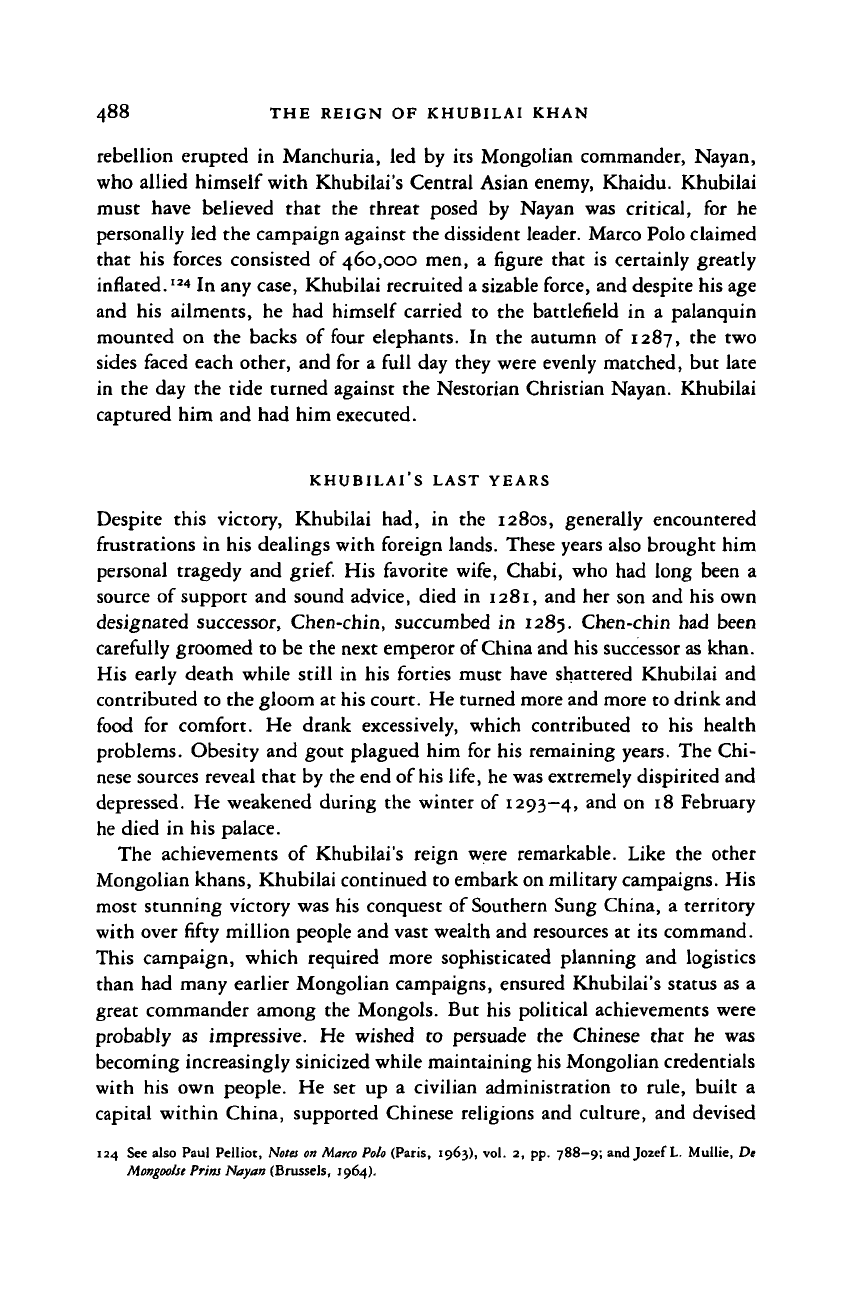
THE REIGN OF KHUBILAI KHAN
rebellion erupted in Manchuria, led by its Mongolian commander, Nayan,
who allied himself with Khubilai's Central Asian enemy, Khaidu. Khubilai
must have believed that the threat posed by Nayan was critical, for he
personally led the campaign against the dissident leader. Marco Polo claimed
that his forces consisted of 460,000 men, a figure that is certainly greatly
inflated.
I34
In any case, Khubilai recruited a sizable force, and despite his age
and his ailments, he had himself carried to the battlefield in a palanquin
mounted on the backs of four elephants. In the autumn of 1287, the two
sides faced each other, and for a full day they were evenly matched, but late
in the day the tide turned against the Nestorian Christian Nayan. Khubilai
captured him and had him executed.
KHUBILAI'S LAST YEARS
Despite this victory, Khubilai had, in the 1280s, generally encountered
frustrations in his dealings with foreign lands. These years also brought him
personal tragedy and
grief.
His favorite wife, Chabi, who had long been a
source of support and sound advice, died in 1281, and her son and his own
designated successor, Chen-chin, succumbed in 1285. Chen-chin had been
carefully groomed to be the next emperor of China and his successor as khan.
His early death while still in his forties must have shattered Khubilai and
contributed to the gloom at his court. He turned more and more to drink and
food for comfort. He drank excessively, which contributed to his health
problems. Obesity and gout plagued him for his remaining years. The Chi-
nese sources reveal that by the end of
his
life, he was extremely dispirited and
depressed. He weakened during the winter of 1293—4,
anc
^
on x
^ February
he died in his palace.
The achievements of Khubilai's reign were remarkable. Like the other
Mongolian khans, Khubilai continued to embark on military campaigns. His
most stunning victory was his conquest of Southern Sung China, a territory
with over fifty million people and vast wealth and resources at its command.
This campaign, which required more sophisticated planning and logistics
than had many earlier Mongolian campaigns, ensured Khubilai's status as a
great commander among the Mongols. But his political achievements were
probably as impressive. He wished to persuade the Chinese that he was
becoming increasingly sinicized while maintaining his Mongolian credentials
with his own people. He set up a civilian administration to rule, built a
capital within China, supported Chinese religions and culture, and devised
124 See also Paul Pelliot, Notes on Marco Polo (Paris, 1963), vol. 2, pp. 788-9; and Jozef L. Mullie, De
Mongoolse
Prim Nayan (Brussels, 1964).
Cambridge Histories Online © Cambridge University Press, 2008
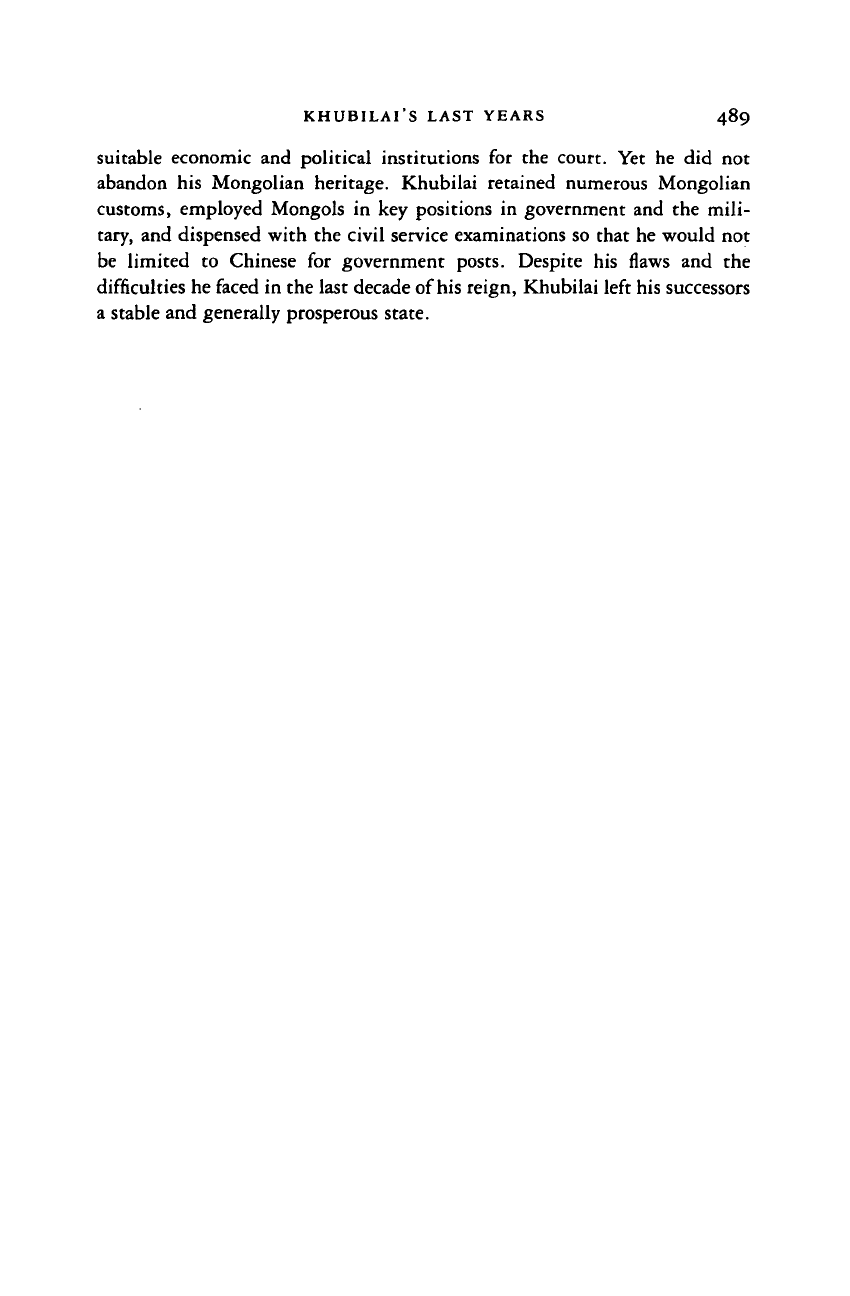
KHUBILAI'S LAST YEARS 489
suitable economic
and
political institutions
for the
court.
Yet he did not
abandon
his
Mongolian heritage. Khubilai retained numerous Mongolian
customs, employed Mongols
in
key positions
in
government and
the
mili-
tary, and dispensed with the civil service examinations so that he would
not
be limited
to
Chinese
for
government posts. Despite
his
flaws
and the
difficulties he faced
in
the last decade of his reign, Khubilai left his successors
a stable and generally prosperous state.
Cambridge Histories Online © Cambridge University Press, 2008
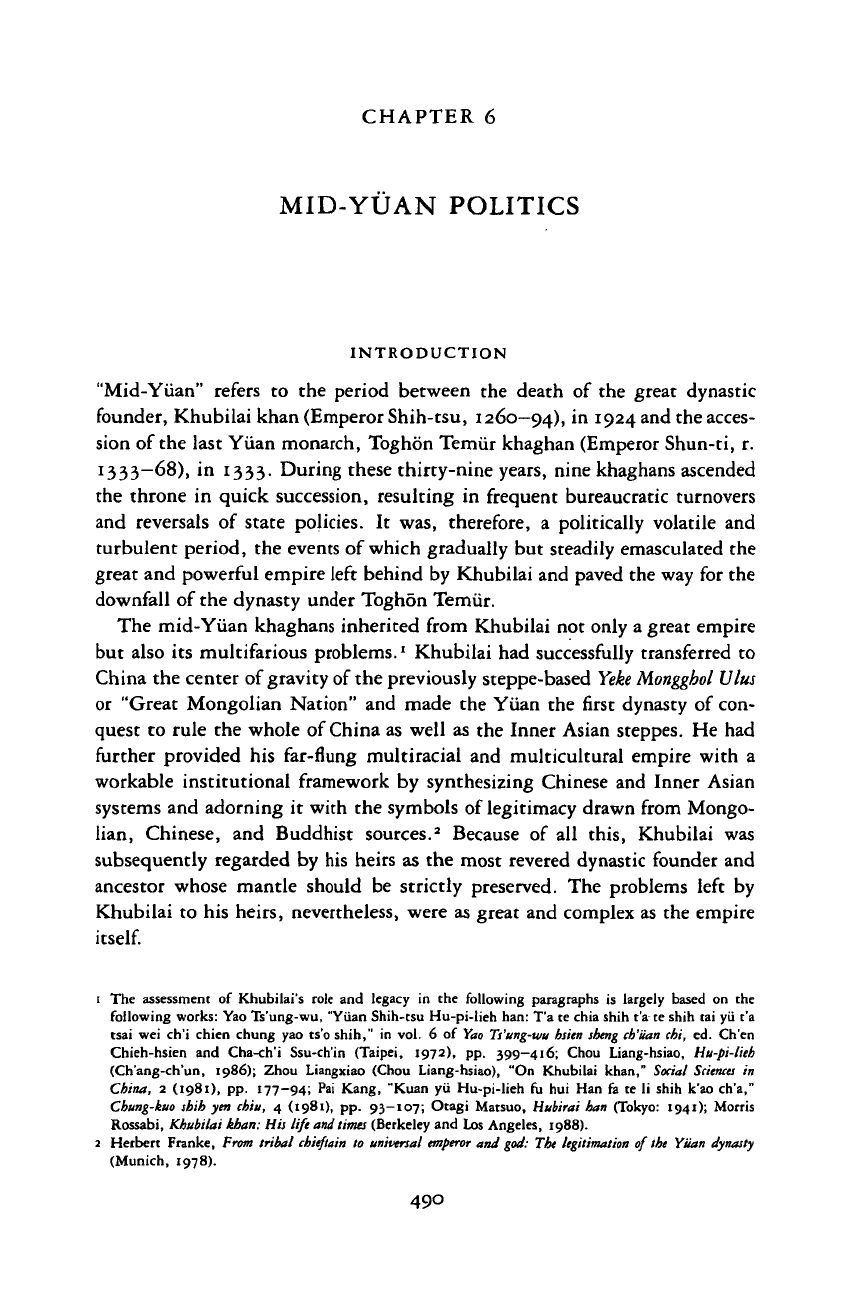
CHAPTER 6
MID-YUAN POLITICS
INTRODUCTION
"Mid-Yuan" refers to the period between the death of the great dynastic
founder, Khubilai khan (Emperor Shih-tsu, 1260—94), in 1924 and the acces-
sion of the last Yuan monarch, Toghon Temiir khaghan (Emperor Shun-ti, r.
1333-68), in 1333. During these thirty-nine years, nine khaghans ascended
the throne in quick succession, resulting in frequent bureaucratic turnovers
and reversals of state policies. It was, therefore, a politically volatile and
turbulent period, the events of which gradually but steadily emasculated the
great and powerful empire left behind by Khubilai and paved the way for the
downfall of the dynasty under Toghon Temiir.
The mid-Yuan khaghans inherited from Khubilai not only a great empire
but also its multifarious problems.
1
Khubilai had successfully transferred to
China the center of gravity of the previously steppe-based
Yeke Mongghol Ulus
or "Great Mongolian Nation" and made the Yuan the first dynasty of con-
quest to rule the whole of China as well as the Inner Asian steppes. He had
further provided his far-flung multiracial and multicultural empire with a
workable institutional framework by synthesizing Chinese and Inner Asian
systems and adorning it with the symbols of legitimacy drawn from Mongo-
lian, Chinese, and Buddhist sources.
2
Because of all this, Khubilai was
subsequently regarded by his heirs as the most revered dynastic founder and
ancestor whose mantle should be strictly preserved. The problems left by
Khubilai to his heirs, nevertheless, were as great and complex as the empire
itself.
1 The assessment of Khubilai's role and legacy in the following paragraphs is largely based on the
following works: Yao Ts'ung-wu, "Yuan Shih-tsu Hu-pi-lieh han: T'a te chia shih t'a te shih tai yii t'a
tsai wei ch'i chien chung yao ts'o shih," in vol. 6 of Yao
Ts'ung-u/u
hsien
sheng ch'iian
chi, ed. Ch'en
Chieh-hsien and Cha-ch'i Ssu-ch'in (Taipei, 1972), pp. 399—416; Chou Liang-hsiao, Hu-pi-lieh
(Ch'ang-ch'un, 1986); Zhou Liangxiao (Chou Liang-hsiao), "On Khubilai khan," Social
Sciences
in
China, 2 (1981), pp. 177—94; Psi Kang, "Kuan yii Hu-pi-lieh fu hui Han fa te li shih k'ao ch'a,"
Chung-kuo shih yen chiu, 4 (1981), pp. 93—107; Otagi Matsuo, Hubirai han (Tokyo: 1941); Morris
Rossabi, Khubilai khan: His life and
times
(Berkeley and Los Angeles, 1988).
2 Herbert Franke, From tribal
chieftain
to universal
emperor
and god: The legitimation of
the
Yuan dynasty
(Munich, 1978).
49O
Cambridge Histories Online © Cambridge University Press, 2008

INTRODUCTION
491
Fundamentally,
the
position
of
the Yuan state
in
both China and
the
broader Mongolian empire needed to be carefully reconsidered and defined,
and further adjustments made accordingly. Did China constitute the most
important part of
the
empire and its primary object of
rule?
Or was it merely
a part of
the
universal Mongolian empire to whose maintenance all of China's
resources should be devoted? The problems of satisfactorily answering these
questions had serious and far-reaching implications for the Yuan rulers. On
the one hand, Khubilai's claim to be the khaghan of all Mongols was difficult
to substantiate and was seriously challenged from the start by his Inner Asian
cousins. The Yuan were still at war with the Ogodei and Chaghadai khanates
at the time of his death. On the other, the pulls of the steppe tradition made
Khubilai reluctant to strike deeper roots in China by completely basing his
dynasty on the traditional Chinese model of government. This slowed down
the process
of
acculturation within the Yuan state and left
a
number
of
important problems to his heirs.
Politically, the system of government created by Khubilai was the product
of a compromise between Mongolian patrimonial feudalism and the tradi-
tional Chinese autocratic—bureaucratic system. Under the original Mongolian
system, imperial relatives and the meritorious retainers of the imperial family
all enjoyed hereditary political, economic,
and
military privileges. Even
though Khubilai did try to curtail the privileges of these aristocrats, he did
not go far enough in this direction, for fear of violating one of
the
fundamen-
tal principles of the Mongolian state, the idea that the empire was the joint
patrimony of all the descendants of Chinggis khan. Consequently, the aristo-
crats continued
to
enjoy much influence and advantages
in
every sphere of
public life, which proved to be a serious source of
financial
strain and political
instability under his
heirs.
In the meantime, Khubilai's attempts to centralize
and bureaucratize his government, however imperfect they were, enabled the
bureaucrats to acquire a much larger share of power than had their predeces-
sors
in
the pre-Khubilai era. The bureaucrats were to become an important
focus of power, often overshadowing the imperial princes and even competing
with the throne for power in the post-Khubilai era.
Culturally and socially, the vast gap between the Mongolian and
se-mu
(Western and Central Asian) elites and their Chinese subjects needed
to
be
bridged. This gap existed partly because the Chinese
in
general suffered
political and social discrimination under an ethnically based system of social
stratification.
It
was especially serious among
the
educated Chinese elite
because Confucian learning and scholars were not given the degree of esteem
that they had been accorded previously under native Chinese dynasties. The
Yuan government recruited the members of its ruling elite on the basis of
ascription rather than achievement. There was, therefore, little incentive for
Cambridge Histories Online © Cambridge University Press, 2008
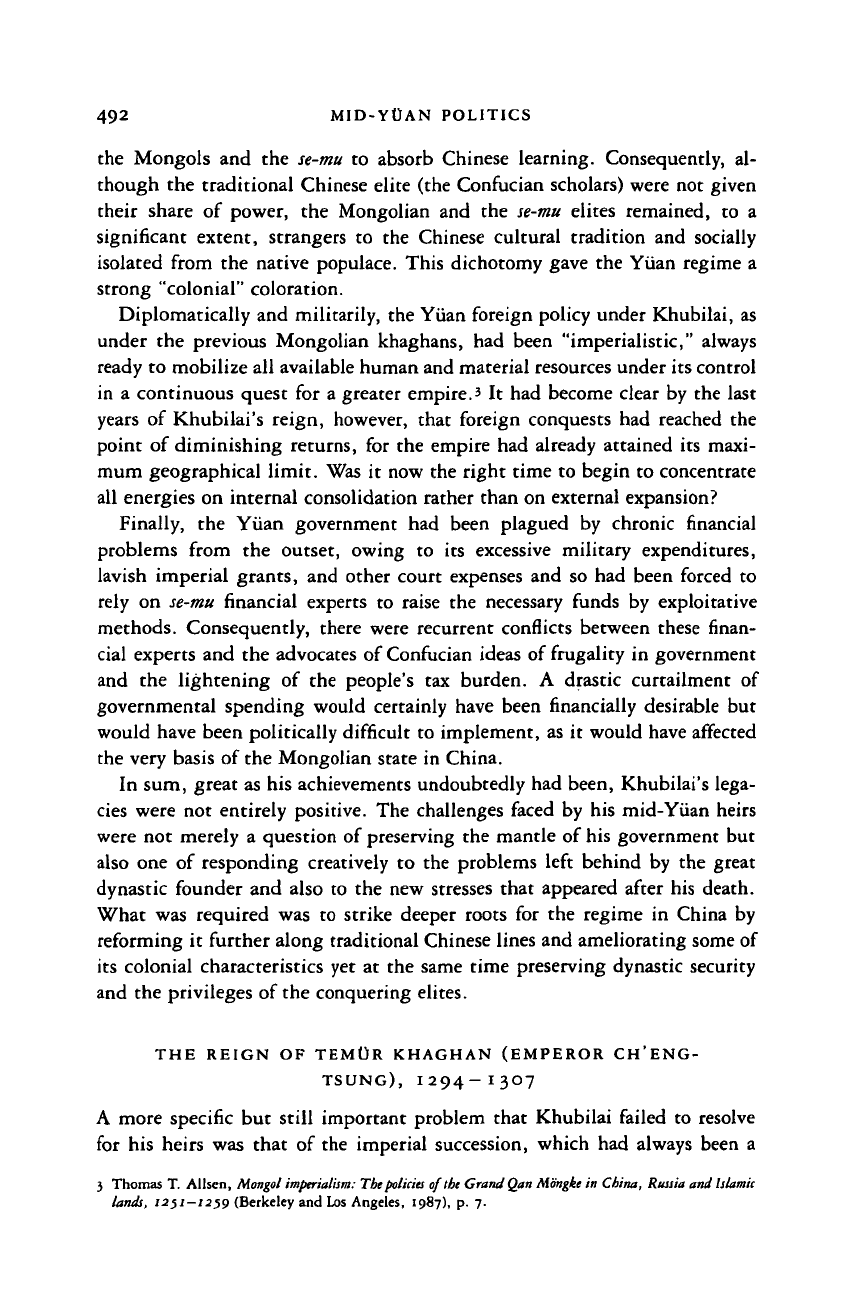
492
MID-YOAN
POLITICS
the Mongols and the
se-mu
to absorb Chinese learning. Consequently, al-
though the traditional Chinese elite (the Confucian scholars) were not given
their share of power, the Mongolian and the
se-mu
elites remained, to a
significant extent, strangers to the Chinese cultural tradition and socially
isolated from the native populace. This dichotomy gave the Yuan regime a
strong "colonial" coloration.
Diplomatically and militarily, the Yuan foreign policy under Khubilai, as
under the previous Mongolian khaghans, had been "imperialistic," always
ready to mobilize all available human and material resources under its control
in a continuous quest for a greater empire.
3
It had become clear by the last
years of Khubilai's reign, however, that foreign conquests had reached the
point of diminishing returns, for the empire had already attained its maxi-
mum geographical limit. Was it now the right time to begin to concentrate
all energies on internal consolidation rather than on external expansion?
Finally, the Yuan government had been plagued by chronic financial
problems from the outset, owing to its excessive military expenditures,
lavish imperial grants, and other court expenses and so had been forced to
rely on
se-mu
financial experts to raise the necessary funds by exploitative
methods. Consequently, there were recurrent conflicts between these finan-
cial experts and the advocates of Confucian ideas of frugality in government
and the lightening of the people's tax burden. A drastic curtailment of
governmental spending would certainly have been financially desirable but
would have been politically difficult to implement, as it would have affected
the very basis of the Mongolian state in China.
In sum, great as his achievements undoubtedly had been, Khubilai's lega-
cies were not entirely positive. The challenges faced by his mid-Yuan heirs
were not merely a question of preserving the mantle of his government but
also one of responding creatively to the problems left behind by the great
dynastic founder and also to the new stresses that appeared after his death.
What was required was to strike deeper roots for the regime in China by
reforming it further along traditional Chinese lines and ameliorating some of
its colonial characteristics yet at the same time preserving dynastic security
and the privileges of the conquering elites.
THE
REIGN
OF TEMOR
KHAGHAN
(EMPEROR
CH'ENG-
TSUNG), 1294-1307
A more specific but still important problem that Khubilai failed to resolve
for his heirs was that of the imperial succession, which had always been a
3 Thomas T. Allsen, Mongol imperialism: The
policies
of
the
Grand Qan MSngte in China, Russia and Islamic
lands, 1251—1239 (Berkeley
and
Los Angeles, 1987),
p. 7.
Cambridge Histories Online © Cambridge University Press, 2008
